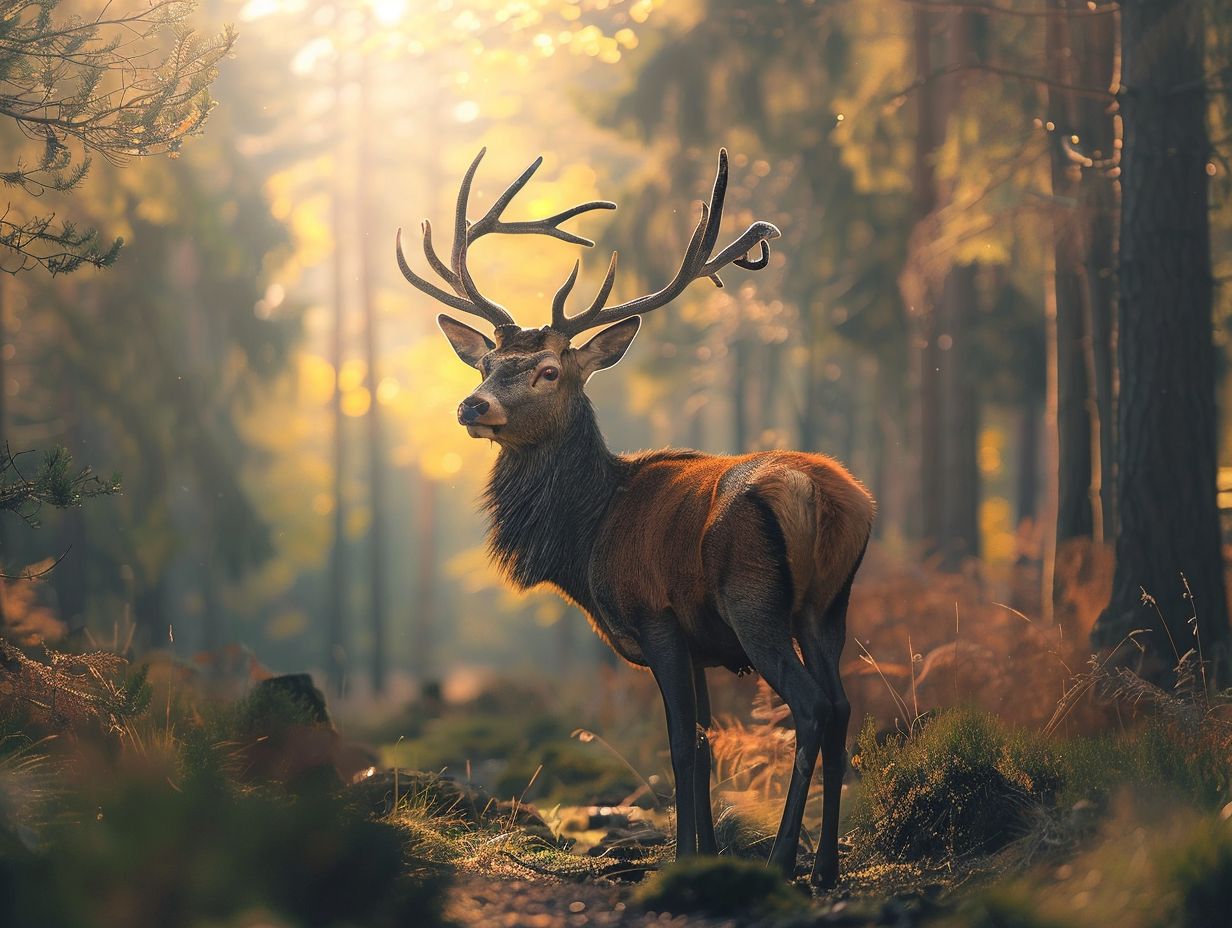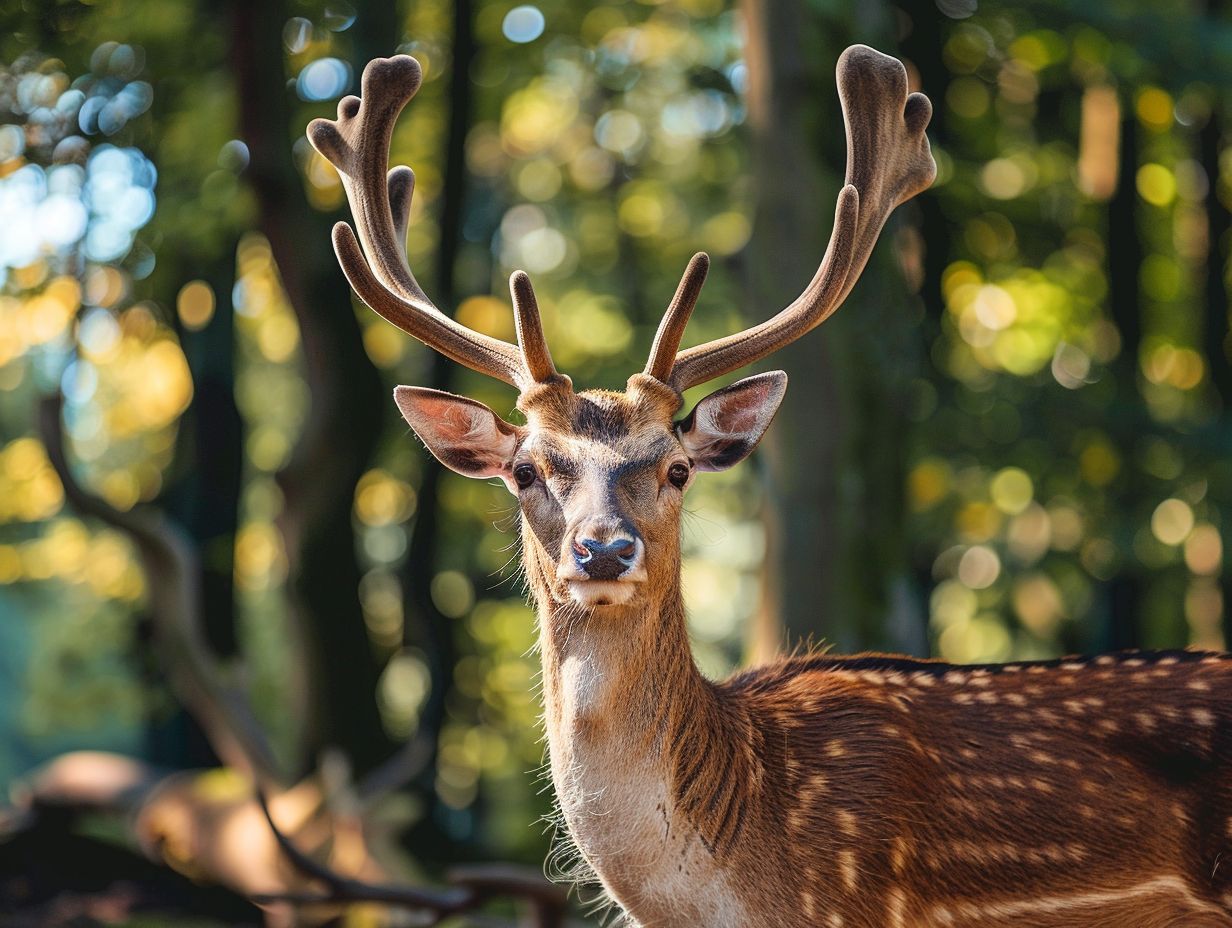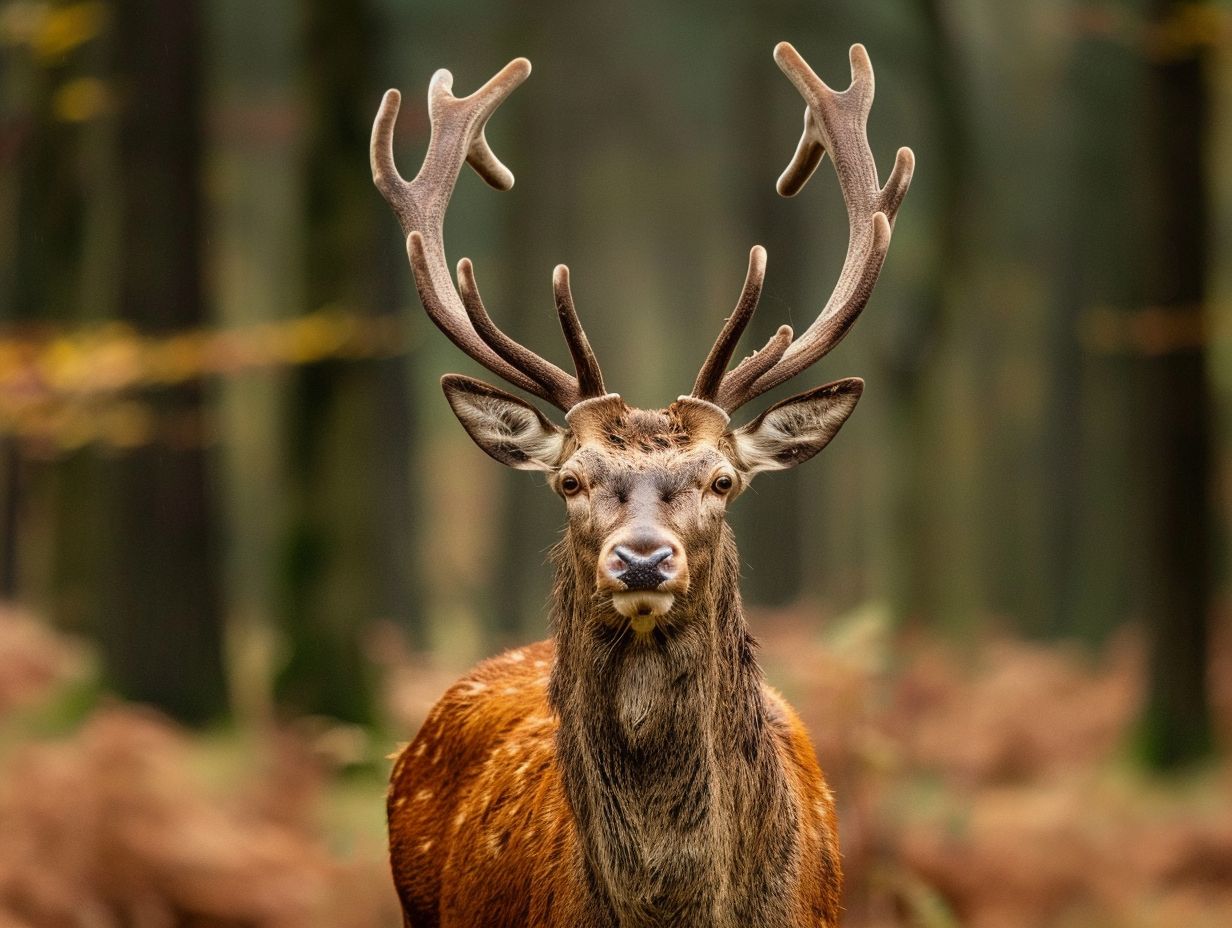What Deer Have Velvet Antlers

Velvet antlers are a unique feature of certain deer species, but what exactly are they and which animals possess them?
We explore the differences between antlers and horns, delve into the natural habitat of deer with velvet antlers, and examine their life cycle, including the mating season.
Discover the purpose of velvet antlers for deer, how they are harvested, and the various uses of this intriguing natural feature.
Join us as we uncover the world of velvet antlers and the fascinating role they play in the lives of these majestic creatures.
Key Takeaways:

- Deer are one of the few animals that have velvet antlers, which are a temporary covering on male deer’s antlers made of soft skin and blood vessels.
- The natural habitat of deer with velvet antlers includes forests and open grasslands, where they can find a variety of plants for food and cover.
- Velvet antlers are important for deer as they are used for communication and defense. They are harvested by carefully removing them while still in the velvet stage and have various uses in traditional medicine.
What Are Velvet Antlers?
Velvet antlers refer to the stage of antler growth where they are covered in a soft, fuzzy skin-like material known as velvet. This stage is crucial for the development and nourishment of the antlers.
The velvet serves as a protective layer for the underlying antler tissue, shielding it from external damage and providing a vital source of nutrients.
This fuzzy covering contains a network of blood vessels that supply essential minerals, such as calcium and phosphorus, necessary for antler growth. Proper blood flow is crucial during this phase, as it ensures efficient delivery of nutrients and oxygen to support the rapid growth of the antlers.
What Animals Have Velvet Antlers?
Velvet antlers are predominantly found in deer species, with white-tailed deer being a prominent example. These animals exhibit the growth and shedding cycle of velvet antlers.
Velvet antlers are a unique feature seen in certain deer species, especially during their annual rutting season. These soft, velvety protrusions serve as a striking visual display of vitality and dominance among the males.
Not only are velvet antlers visually impressive, but they also play a crucial role in the mating rituals and competition for mates in these species. The velvet covering is a highly vascularized layer that supplies essential nutrients to the growing antlers, aiding in their rapid growth and development.
What is the Difference Between Antlers and Horns?
Antlers and horns are both bony structures found in animals, but they differ in nature and composition. Antlers are shed and regrown annually, while horns are permanent structures.
Antlers are found predominantly in species like deer, elk, and moose. They are composed of bone-like tissue and are grown from pedicles on the skull. The process of antler growth is regulated by hormones and is influenced by the animal’s age, health, and genetics.
In contrast, horns are unbranched, permanent structures made of keratin over a bony core. They are typically found in bovids like cattle, sheep, and goats. Horns continue to grow throughout an animal’s life, often showing rings of growth. The distinctive characteristic of antlers, being shed and regenerated, serves various purposes such as mate selection, defense, and dominance in mating competitions.
What Deer Have Velvet Antlers?
Deer species, including white-tailed deer, are known to have velvet antlers during specific stages of their growth cycle. The presence of velvet antlers is a distinctive characteristic of these animals.
Velvet antlers refer to the stage when a deer’s antlers are covered in a layer of fuzzy skin. This velvet, rich in blood vessels and nerves, provides vital nutrients and aids in the rapid growth of the antlers.
As the antlers mature, the velvet dries up and falls off, revealing the hardened antlers underneath. The growth of velvet antlers is a meticulous process, crucial for ensuring strong, impressive antler development in male deer.
- During the velvet stage, deer use their antlers for a variety of purposes, including marking territory and attracting mates. The soft texture of velvet antlers makes them ideal for gentle interactions, such as grooming and establishing dominance within a herd.
- Whitetails, in particular, rely on their velvet antlers for communication during mating season. The scent glands on the antlers release pheromones that convey information about the deer’s health, age, and status to potential mates.
What is the Natural Habitat of Velvet Antler Deer?

Deer with velvet antlers thrive in diverse habitats ranging from forests to grasslands, where they rely on vegetation for sustenance and cover. Understanding their natural habitat is crucial for wildlife conservation efforts and proper wildlife management.
In forests, deer find plentiful sustenance in the form of leaves, twigs, and fruits, which provide essential nutrients for their growth. The thick canopy offers them protection from predators and also serves as a refuge during harsh weather conditions.
- On the other hand, in grasslands, deer benefit from the open spaces that allow them to graze freely on a variety of grasses, herbs, and shrubs.
- This diverse vegetation not only supports their nutritional needs but also contributes to the diversity of the ecosystem.
The relationship between prey and predator plays a vital role in shaping deer behavior in their habitat. The presence of natural predators such as wolves or big cats influences their movement patterns and feeding habits, keeping the ecosystem in balance.
What is the Life Cycle of Deer with Velvet Antlers?
The life cycle of deer with velvet antlers involves distinct growth stages, including the antler cycle that encompasses the shedding process. Understanding this cycle is crucial for researchers and wildlife experts.
During the initial stage of the life cycle, young deer are born with small, cartilaginous antler buds that gradually grow in size and complexity as the deer mature. These velvet antlers are covered in a soft, fuzzy skin called velvet, which provides them with a rich blood supply for rapid growth.
As the antlers reach peak size, the deer enter the second stage, where the velvet skin dries up and the deer experience an itching sensation, prompting them to rub their antlers against trees to aid in the shedding process.
This shedding phase is a critical period where the deer’s antlers are at their peak sensitivity and vulnerability. Researchers closely monitor this process to understand the timing and mechanisms of shedding, as it plays a crucial role in the overall health and vitality of the deer population.
By studying these growth patterns and shedding behaviors, scientists can gain insights into the deer’s health, reproductive success, and overall population dynamics.
What is the Mating Season for Deer with Velvet Antlers?
The mating season for deer with velvet antlers, characterized by heightened hormone levels including testosterone and IGF, plays a vital role in their reproductive behavior and cycle. Understanding this season is crucial for wildlife management.
During this period, male deer experience a surge in testosterone levels, which triggers aggressive behaviors and competition among them for mates. This heightened aggression is essential for establishing dominance within the herd and gaining access to females in estrus.
Along with testosterone, Insulin-like Growth Factor (IGF) also plays a significant role in influencing mating behaviors. IGF is involved in the development of antler growth and overall physical condition, impacting the deer’s ability to compete successfully during the breeding season.
How Long Does It Take for Deer Antlers to Regrow?
The regrowth of deer antlers varies depending on the species, but on average, it takes several months for antlers to fully regrow after shedding. This regrowth process is a critical aspect of the deer’s cycle.
After shedding their antlers, deer enter a phase where the regrowth cycle begins. This phase typically aligns with the seasonal changes. Once shedding occurs, the growth centers on the deer’s frontal skull become active again.
Regeneration of antlers is a complex process influenced by various factors such as age, genetics, nutrition, and environmental conditions. Specifically, nutrition plays a crucial role in providing the necessary minerals and proteins for strong and healthy antler regrowth.
What is the Purpose of Velvet Antlers for Deer?
Velvet antlers serve multiple purposes for deer, including providing essential nutrients, protection, and influencing their behavior. Understanding the significance of velvet antlers is key to wildlife conservation efforts.
During the growth phase, velvet antlers are rich in blood vessels and nerves, allowing for rapid development and sensitivity. These antlers play a pivotal role in attracting mates during the mating season, showcasing the deer’s strength and health.
Velvet antlers act as a protective layer, shielding the underlying bone structure as they grow and harden. Once fully developed, they aid in combat between males during territorial disputes, further emphasizing their importance in the deer’s ecosystem.
How Do Deer Use Velvet Antlers for Communication?

Deer use velvet antlers as a form of communication during the rutting season, emitting scents and odors that convey information to other deer. This behavior plays a crucial role in their social interactions.
During the rutting season, male deer actively rub their velvet antlers on trees and shrubs to deposit their scent, marking their territory and signaling their presence to potential mates and rivals. The pheromones released through these antlers carry chemical cues that indicate the deer’s readiness to mate or their dominance within the herd.
These odors not only serve as signals for mating but also help establish a hierarchy among deer, with the more dominant individuals often having stronger or more pungent scents. By interpreting these scents, deer can assess the status and strength of their competitors, informing their social interactions and mating decisions.
How Do Deer Use Velvet Antlers for Defense?
Deer employ velvet antlers for defense against predators and territorial disputes, utilizing their antlers to deter threats and assert dominance. Injuries and deformities can impact their defensive capabilities.
Velvet antlers, covered in a soft skin called velvet, are a weapon of choice for deer in the wild. The velvet layer provides a rich blood supply, which aids in antler growth and protection.
When faced with danger, deer may use their antlers to intimidate predators or rival deer by displaying their size and strength. This display of dominance can help them maintain their territory and protect themselves from potential threats.
Despite the benefits, there are risks involved. The process of using antlers for defense can expose deer to injuries and deformities, reducing their agility and overall survival rate. An injury to the antlers can lead to a long-term impact on a deer’s ability to defend itself effectively, making them vulnerable in the harsh realities of the animal kingdom.
How are Velvet Antlers Harvested?
The harvesting of velvet antlers involves a careful process that may include the use of mineral supplements like Wild Water® Mineral Supplements to support healthy antler growth. Proper harvesting techniques are essential to ensure the well-being of the deer.
During the velvet harvesting process, it is crucial to take into account the ethical considerations surrounding the practice. This involves respecting the natural cycles of the deer and ensuring that they are treated with care and compassion throughout the process.
Utilizing mineral supplements such as Wild Water® Mineral Supplements can play a significant role in enhancing the quality and size of the antlers, making the harvest more productive and beneficial for both the animals and the environment.
What is the Process of Harvesting Velvet Antlers?
The process of harvesting velvet antlers involves skilled experts who carefully remove the velvet from the antlers without causing harm to the deer. This process requires precision and knowledge of deer anatomy.
Skilled experts like Austin Delano and researchers such as Dr. Grant Woods play key roles in advancing the techniques used in the delicate process of harvesting velvet antlers. These experts meticulously study deer behavior and biology to ensure a safe and ethical harvest.
Careful observation and understanding of the growth patterns of antlers are crucial in this process. Professionals in this field need to be equipped with a deep understanding of deer physiology to achieve the delicate extraction of velvet.
What Are the Uses of Velvet Antlers?
Velvet antlers are utilized for various purposes, including as a source of minerals like calcium, phosphorus, and protein. These essential nutrients are beneficial for human consumption and traditional medicine practices.
Regarding dietary supplements, velvet antlers are often processed into capsules, powders, or extracts to harness their nutritional value. These supplements are popular among individuals looking to increase their mineral intake or benefit from the believed medicinal properties of velvet antlers.
In traditional Chinese medicine, velvet antlers have been used for centuries due to their perceived ability to nourish vital energy and support overall health. They are believed to have rejuvenating properties and are used to address issues ranging from weakness to joint discomfort.
Frequently Asked Questions

What deer have velvet antlers?
Among the species of deer, only male deer in the Cervidae family have velvet antlers. This includes members of the subfamily Cervinae (such as red deer, elk, and moose) and members of the subfamily Capreolinae (such as roe deer, reindeer, and mule deer).
Why do deer have velvet antlers?
Deer grow velvet antlers as a way to attract mates during the breeding season. The soft, fuzzy covering on their antlers is rich in blood vessels, providing nutrients for the rapid growth of the antlers.
When do deer have velvet antlers?
Deer typically start growing velvet antlers in the spring, and they shed the velvet in late summer or early fall. The timing may vary depending on the species and individual deer, but velvet antlers are usually present during the summer months.
Do female deer have velvet antlers?
No, female deer do not have velvet antlers. Only male deer grow antlers, and it is mainly for the purpose of attracting mates and competing with other males during the breeding season.
What happens to the velvet after deer shed their antlers?
After shedding the velvet, deer will rub their antlers against trees and other objects to remove any remaining pieces. The antlers then harden and become solid bone, ready for use in mating rituals and defense.
Are velvet antlers used for any other purposes?
Yes, velvet antlers have been used in traditional Chinese medicine for centuries to treat various ailments and to boost overall health. They are believed to contain beneficial hormones, amino acids, and minerals.